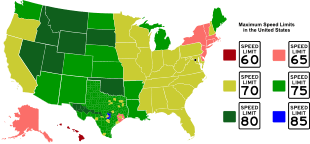Speed limits in the United States
Speed limits in the United States are set by each state or territory. States have also allowed counties and municipalities to enact typically lower limits. Highway speed limits can range from an urban low of 20 mph (32 km/h) to a rural high of 85 mph (137 km/h). Speed limits are typically posted in increments of five miles per hour (8 km/h). Some states have lower limits for trucks and at night, and occasionally there are minimum speed limits.
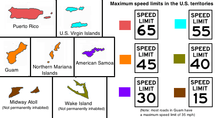
The highest speed limits are generally 70 mph (113 km/h) on the West Coast and the inland eastern states, 75–80 mph (121–129 km/h) in inland western states, along with Arkansas and Louisiana, and 65–70 mph (105–113 km/h) on the Eastern Seaboard. Alaska, Connecticut, Delaware, Massachusetts, New Jersey, New York,[1] Puerto Rico, Rhode Island, and Vermont have a maximum limit of 65 mph (105 km/h), and Hawaii has a maximum limit of 60 mph (97 km/h). The District of Columbia and the U.S. Virgin Islands have a maximum speed limit of 55 mph (89 km/h). Guam and the Northern Mariana Islands have speed limits of 45 mph (72 km/h). American Samoa has a maximum speed limit of 30 mph (48 km/h).[2] Two territories in the U.S. Minor Outlying Islands have their own speed limits: 40 mph (64 km/h) in Wake Island, and 15 mph (24 km/h) in Midway Atoll.[3][4] Unusual for any state east of the Mississippi River, much of Interstate 95 (I-95) in Maine north of Bangor allows up to 75 mph (121 km/h), and the same is true for up to 600 mi (966 km) of freeways in Michigan. Portions of the Idaho, Montana, Nevada, South Dakota, Texas, Utah, and Wyoming road networks have 80 mph (129 km/h) posted limits. The highest posted speed limit in the country is 85 mph (137 km/h) and can be found only on Texas State Highway 130.



During World War II, the U.S. Office of Defense Transportation established a national 35 mph "Victory Speed Limit" to conserve gasoline and rubber for the American war effort,[5] from May 1942 to August 1945, when the war ended. For 13 years (January 1974[6]–April 1987[7][8]), federal law withheld Federal highway trust funds to states that had speed limits above 55 mph (89 km/h).[7] From April 1987 to December 8, 1995, an amended federal law allowed speed limits up to 65 mph (105 km/h) on rural Interstate and rural roads built to Interstate highway standards.
Overview
Speed limits
This table contains the most usual posted daytime speed limits, in miles per hour, on typical roads in each category. The values shown are not necessarily the fastest or slowest. They usually indicate, but not always, statutory speed limits. Some states and territories have lower truck speed limits applicable to heavy trucks. If present, they are usually only on freeways or other high-speed roadways. Washington allows for speeds up to 75 mph (121 km/h), but the highest posted signs are 70 mph (110 km/h). Mississippi allows speeds up to 80 mph (129 km/h) on toll roads, but no such roads exist.
| Legend: | ||
|---|---|---|
|
Freeway: Interstate Highway or other state or U.S. Route built to Interstate standards. Divided rural: State or U.S. route, generally with four or more lanes, not built to Interstate standards, but with a median or other divider separating directions of travel. Undivided rural: County, State, or U.S. route, generally with two to four lanes, with no separator between directions of travel. Residential Street/residential: Residential streets, business districts, or School zones. | ||
|
|
|
| State or territory | Freeway (rural) | Freeway (trucks) | Freeway (urban) | Divided (rural) | Undivided (rural) | Residential |
|---|---|---|---|---|---|---|
| 70 mph (113 km/h) | 55–70 mph (89–113 km/h) | 65 mph (105 km/h) | 55 mph (89 km/h) | 20–25 mph (32–40 km/h) | ||
| 65 mph (105 km/h) | 55–65 mph (89–105 km/h) | 55–65 mph (89–105 km/h) | 45–65 mph (72–105 km/h) | 20–25 mph (32–40 km/h) | ||
| no freeways in American Samoa | 30 mph (48 km/h)[2][11] | 30 mph (48 km/h)[2][11] | 15 mph (24 km/h)[11] | |||
| 65–75 mph (105–121 km/h) | 55–65 mph (89–105 km/h) | 55–65 mph (89–105 km/h) | 45–65 mph (72–105 km/h) | 20–25 mph (32–40 km/h) | ||
| 75 mph (121 km/h) | 70 mph (113 km/h) | 65 mph (105 km/h) | 65 mph (105 km/h) | 55–65 mph (89–105 km/h) | 30 mph (48 km/h) | |
| 65–70 mph (105–113 km/h) | 55 mph (89 km/h) | 50–65 mph (80–105 km/h) | 65 mph (105 km/h)[14] | 55–65 mph (89–105 km/h) | 25–30 mph (40–48 km/h) | |
| 65–75 mph (105–121 km/h) | 55–75 mph (89–121 km/h) | 55–65 mph (89–105 km/h) | 55–65 mph (89–105 km/h) | 20–35 mph (32–56 km/h) | ||
| 65 mph (105 km/h) | 45–55 mph (72–89 km/h) | 50–55 mph (80–89 km/h) | 45–50 mph (72–80 km/h) | 20–40 mph (32–64 km/h) | ||
| 65 mph (105 km/h) | 50–65 mph (80–105 km/h) | 55 mph (89 km/h) | 50 mph (80 km/h) | 20–35 mph (32–56 km/h) | ||
| no rural freeways in D.C. | 55 mph (89 km/h) | no rural roads in D.C. | 25 mph (40 km/h) | |||
| 70 mph (113 km/h) | 45–70 mph (72–113 km/h) | 55–65 mph (89–105 km/h) | 55–60 mph (89–97 km/h) | 20–50 mph (32–80 km/h) | ||
| 70 mph (113 km/h) | 55–70 mph (89–113 km/h) | 65 mph (105 km/h) | 45–55 mph (72–89 km/h) | 25–45 mph (40–72 km/h) | ||
| no freeways in Guam | 45 mph (72 km/h) | 35–45 mph (56–72 km/h) | 35 mph (56 km/h) | |||
| 55–60 mph (89–97 km/h) | 35–50 mph (56–80 km/h) | 45–55 mph (72–89 km/h) | 45–60 mph (72–97 km/h) | 25 mph (40 km/h) | ||
| 70–80 mph (113–129 km/h) | 70 mph (113 km/h) | 60–65 mph (97–105 km/h) | 65–70 mph (105–113 km/h) | 55–70 mph (89–113 km/h) | 25–35 mph (40–56 km/h) | |
| 70 mph (113 km/h) | 45–70 mph (72–113 km/h) | 65 mph (105 km/h) | 55 mph (89 km/h) | 20–30 mph (32–48 km/h) | ||
| 70 mph (113 km/h) | 65 mph (105 km/h) | 50–70 mph (80–113 km/h) | 55–60 mph (89–97 km/h) | 50–55 mph (80–89 km/h) | 20–30 mph (32–48 km/h) | |
| 70 mph (113 km/h) | 55–65 mph (89–105 km/h) | 65 mph (105 km/h) | 45–55 mph (72–89 km/h) | 25 mph (40 km/h) | ||
| 75 mph (121 km/h) | 60–75 mph (97–121 km/h) | 65–70 mph (105–113 km/h) | 55–65 mph (89–105 km/h) | 20–30 mph (32–48 km/h) | ||
| 70 mph (113 km/h) | 55–70 mph (89–113 km/h) | 65 mph (105 km/h) | 55 mph (89 km/h) | 25–45 mph (40–72 km/h) | ||
| 70–75 mph (113–121 km/h) | 50–70 mph (80–113 km/h) | 55–65 mph (89–105 km/h) | 45–55 mph (72–89 km/h) | 20–45 mph (32–72 km/h) | ||
| 70–75 mph (113–121 km/h) | 50–65 mph (80–105 km/h) | 45–55 mph (72–89 km/h) | 45–55 mph (72–89 km/h) | 25 mph (40 km/h) | ||
| 65–70 mph (105–113 km/h) | 40–65 mph (64–105 km/h) | 55 mph (89 km/h) | 50–55 mph (80–89 km/h) | 20–25 mph (32–40 km/h) | ||
| 65 mph (105 km/h) | 45–65 mph (72–105 km/h) | 45–55 mph (72–89 km/h) | 45–55 mph (72–89 km/h) | 20–30 mph (32–48 km/h) | ||
| 70–75 mph (113–121 km/h)[25] | 65 mph (105 km/h) | 55–70 mph (89–113 km/h) | 55–65 mph (89–105 km/h) | 55–65 mph (89–105 km/h)[25] | 25 mph (40 km/h) | |
| no freeways in the Midway Islands | 15 mph (24 km/h) | |||||
| 70 mph (113 km/h) | 45–60 mph (72–97 km/h) | 60–65 mph (97–105 km/h) | 55–60 mph (89–97 km/h) | 30 mph (48 km/h) | ||
| 70 mph (113 km/h) | 55–70 mph (89–113 km/h) | 65 mph (105 km/h) | 55 mph (89 km/h) | 25 mph (40 km/h) | ||
| 70 mph (113 km/h) | 45–70 mph (72–113 km/h) | 60–70 mph (97–113 km/h) | 45–65 mph (72–105 km/h) | 25–40 mph (40–64 km/h) | ||
| 75–80 mph (121–129 km/h) | 70 mph (110 km/h) | 65 mph (105 km/h) | 65–70 mph (105–113 km/h) | 55–70 mph (89–113 km/h) | 20–25 mph (32–40 km/h) | |
| 75 mph (121 km/h) | 55–75 mph (89–121 km/h) | 65–70 mph (105–113 km/h) | 55–70 mph (89–113 km/h) | 25 mph (40 km/h) | ||
| 70–80 mph (113–129 km/h)[29][30][31] | 55–65 mph (89–105 km/h) | 65–75 mph (105–121 km/h) | 55–70 mph (89–113 km/h) | 20–30 mph (32–48 km/h) | ||
| 65–70 mph (105–113 km/h) | 50–65 mph (80–105 km/h) | 55 mph (89 km/h) | 35–55 mph (56–89 km/h) | 20–30 mph (32–48 km/h) | ||
| 65 mph (105 km/h) | 50–65 mph (80–105 km/h) | 55 mph (89 km/h) | 30–55 mph (48–89 km/h) | 20–35 mph (32–56 km/h) | ||
| 75 mph (121 km/h) | 55–75 mph (89–121 km/h) | 55–75 mph (89–121 km/h) | 55–75 mph (89–121 km/h) | 20–55 mph (32–89 km/h) | ||
| 65 mph (105 km/h) | 35–55 mph (56–89 km/h) | 45–55 mph (72–89 km/h) | 35–55 mph (56–89 km/h) | 20–45 mph (32–72 km/h) | ||
| 65–70 mph (105–113 km/h) | 50–70 mph (80–113 km/h) | 55–60 mph (89–97 km/h)[38] | 55 mph (89 km/h) | 20–35 mph (32–56 km/h) | ||
| 75 mph (121 km/h) | 55–75 mph (89–121 km/h) | 70 mph (113 km/h) [41] | 55–65 mph (89–105 km/h) | 20–55 mph (32–89 km/h)[41] | ||
| no freeways in Northern Mariana Islands | 45 mph (72 km/h) | 25 mph (40 km/h) | ||||
| 70 mph (113 km/h) | 50–70 mph (80–113 km/h) | 55–70 mph (89–113 km/h)[45][46] | 45–55 mph (72–89 km/h) | 20–35 mph (32–56 km/h) | ||
| 70–75 mph (113–121 km/h) (75–80 mph (121–129 km/h) turnpikes) | 55–65 mph (89–105 km/h) | 65–70 mph (105–113 km/h) | 55–65 mph (89–105 km/h) | 25 mph (40 km/h) | ||
| 65-70 mph
(105–113 km/h) |
60–65 mph (97–105 km/h) | 50–60 mph (80–97 km/h) | 55–70 mph (89–113 km/h) | 55–70 mph (89–113 km/h) | 20–25 mph (32–40 km/h) | |
| 65–70 mph (105–113 km/h) | 40–70 mph (64–113 km/h) | 55 mph (89 km/h) | 35–55 mph (56–89 km/h) | 20–35 mph (32–56 km/h) | ||
| 60–65 mph (97–105 km/h) | 55 mph (89 km/h) | 50–55 mph (80–89 km/h) | 55 mph (89 km/h) | 45–55 mph (72–89 km/h) | 25–35 mph (40–56 km/h) | |
| 65 mph (105 km/h) | 50–55 mph (80–89 km/h) | 55 mph (89 km/h) | 50 mph (80 km/h) | 20–25 mph (32–40 km/h) | ||
| 70 mph (113 km/h) | 60 mph (97 km/h) | 60 mph (97 km/h) | 45–55 mph (72–89 km/h) | 20–30 mph (32–48 km/h) | ||
| 75–80 mph (121–129 km/h) | 60–75 mph (97–121 km/h) | 65–70 mph (105–113 km/h) | 55–65 mph (89–105 km/h) | 20–45 mph (32–72 km/h) | ||
| 65–70 mph (105–113 km/h) | 55–70 mph (89–113 km/h) | 55–65 mph (89–105 km/h) | 35–55 mph (56–89 km/h) | 30 mph (48 km/h) | ||
| 75–85 mph (121–137 km/h) | 55–75 mph (89–121 km/h) | 75 mph (121 km/h) | 55–75 mph (89–121 km/h) | 25–30 mph (40–48 km/h) | ||
| no freeways in the United States Virgin Islands | 55 mph (89 km/h) | 30–45 mph (48–72 km/h) | 20–25 mph (32–40 km/h) | |||
| 75–80 mph (121–129 km/h) | 65–70 mph (105–113 km/h)[55] | 55–65 mph (89–105 km/h)[56] | 55–65 mph (89–105 km/h) | 20–35 mph (32–56 km/h) | ||
| 65 mph (105 km/h) | 55 mph (89 km/h) | 55 mph (89 km/h) | 50–55 mph (80–89 km/h) | 20–50 mph (32–80 km/h) | ||
| 65–70 mph (105–113 km/h) | 55–70 mph (89–113 km/h) | 55–60 mph (89–97 km/h) | 55 mph (89 km/h) | 20–35 mph (32–56 km/h) | ||
| no freeways in Wake Island | 40 mph (64 km/h) | |||||
| 70 mph (113 km/h)[lower-alpha 1][58] | 60 mph (97 km/h) | 60 mph (97 km/h) | 65–70 mph (105–113 km/h) | 55–65 mph (89–105 km/h) | 20–50 mph (32–80 km/h) | |
| 60–70 mph (97–113 km/h) | 55–65 mph (89–105 km/h) | 65 mph (105 km/h) | 55 mph (89 km/h) | 20–55 mph (32–89 km/h) | ||
| 70 mph (113 km/h) | 50–70 mph (80–113 km/h) | 65 mph (105 km/h) | 55 mph (89 km/h) | 20–35 mph (32–56 km/h) | ||
| 75–80 mph (121–129 km/h) | 60–75 mph (97–121 km/h) | 70 mph (113 km/h) | 55–70 mph (89–113 km/h) | 30 mph (48 km/h) | ||
| legend: | ||
|---|---|---|
|
Freeway: Interstate Highway or other state- or federally numbered road built to Interstate standards. Divided: State- or federally numbered road, generally with four or more lanes, not built to Interstate standards, but with a median or other divider separating directions of travel. Undivided rural: County, State, or U.S. route, generally with two to four lanes, with no separator between directions of travel. Residential Street/residential: Residential streets, business districts, or School zones. | ||
|
|
|
Examples of related laws
| State | Typical fine and whether absolute or prima facie* | Recklessness threshold or enhanced penalty | Ticket dismissal options | Point system |
|---|---|---|---|---|
| (Not available or information needed.) Prima facie (Absolute above 85 mph (137 km/h)) | Over 35 mph (56 km/h) in a school zone, over 20 mph (32 km/h) above the posted speed limit, or over 85 mph (137 km/h) regardless of the posted speed limit.[61] | Defensive driving school (requires court approval for criminal speeding tickets). | Point system leading to fines, potential license suspension, increased insurance rates, and potential jail time (if criminal). | |
| $10–$50 plus court costs.[62] Speeding fines in work zones and school zones are $250 plus court costs. Absolute | 15 mph (24 km/h) over limit at a travelled speed of greater than 55 mph (89 km/h) or over 80 mph (130 km/h) | Prayer for judgment continued (PJC) available depending on the court and subject to their discretion, but not available for charges of exceeding a speed limit by more than 25 mph (40 km/h). | Point system may lead to license suspension. Exceeding the speed limit by more than 15 mph (24 km/h) with a speed of greater than 55 mph (89 km/h) or travelling faster than 80 mph (130 km/h) results in a minimum 30-day license suspension.[63] | |
| $35[64] plus court and other costs. All fines doubled in active work zones. Absolute | Over 30 mph (48 km/h) over limit | None | Point system leads to mandatory driver education and possible license suspension. | |
| $1–$200[65] plus court fees. Doubled in active school zones when children are present or construction zones when workers are present.[66] Various additional "fees" assessed by the state essentially increase the fine by around $100 on all tickets. Prima facie[67] | None[68] | Defensive driving[69] (once per year) or deferred disposition[70] (restrictions vary, but generally at least 4 per year), but only valid if:
|
Point system is annual surcharge only. No provision for license suspension if surcharges are paid.[71] | |
|
(Not available or information needed) Prima facie |
One dismissal every 3 years for speed 14 mph (23 km/h) or less over limit.[72] | |||
Absolute[77] |
20 mph (32 km/h) over limit or over 80 mph (130 km/h)[78][79] (over 85 mph (137 km/h) as of July 1, 2020)[80] | Point system[81] leading to fines, suspension, and mandatory driver education.[82] |
| Estimated Miles of Highway and Estimated Daily Vehicle-Miles Traveled by Traffic Volume Group | |
 |
 |
| Based on arterial and (major) collector sample data from the 2000 Highway Performance Monitoring System[83] | |
History
One of the first speed limits in what would become the United States (at the time, still a British colony) was set in Boston in 1701 by the board of selectmen (similar to a city council):
Ordered, That no person whatsoever Shall at any time hereafter ride or drive a gallop or other extream pace within any of the Streets, lanes, or alleys in this Town on penalty of forfeiting three Shillings for every such offence, and it may be lawfull for any of the Inhabitants of this Town to make Stop of such horse or Rider untill the name of the offender be known in order to prosecution[84]
Federal speed controls
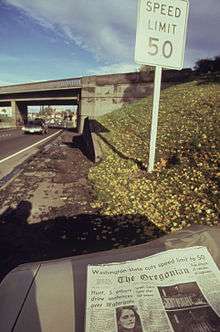
In response to the 1973 oil crisis, Congress enacted the National Maximum Speed Law that created the universal 55 miles per hour (89 km/h) speed limit. States had to agree to the limit if they desired to receive federal funding for highway repair. The federal government enforced the national maximum speed limit by withholding federal funding for projects whose speed limits exceeded 55 miles per hour (89 km/h). Federal highway funding is normally allocated according to 23 U.S. Code § 106,[85] the National Maximum Speed Law (also known as H.R.11372 - An Act to conserve energy on the Nation's highways) modified the allocation process. As stated, in part:
...the Secretary of Transportation shall not approve any project under section 106 of title 23 of the United States Code in any State which has...a maximum speed limit on any public highway within its jurisdiction in excess of 55 miles per hour...[86]
Whether the lowered speed limits reduced gasoline consumption or not has been debated, and the impact on safety is unclear; studies and opinions of safety advocates are mixed.
In 1984, a comprehensive study by the National Research Council found that the lower speed limits contributed to saving 3,000 to 5,000 lives in 1974 and from 2,000 to 4,000 lives each year thereafter, due to slower and more uniform speeds on American highways.[87]
1995 repeal
Furthermore, in April 2019, the Insurance Institute for Highway Safety (IIHS) confirmed the increase of speed limits not only increases the speed of vehicles but can also generate additional deaths: "A 5 mph increase in the maximum state speed limit was associated with an 8.5% increase in fatality rates on interstates/freeways and a 2.8% increase on other roads."[88]
Statistical records of motor vehicle fatalities since the repeal of the 55 miles per hour (89 km/h) National Maximum Speed Limit in 1995 indicate that total traffic deaths in the United States have declined from 41,817 that year to 32,479 in 2011, the lowest level in 60 years, before increasing to 37,133 in 2017.[89]
The April 2019 Insurance Institute for Highway Safety (IIHS) document attributes a decrease of fatalities to cause other than speed limit, such as time, wearing seat belt or unemployment rate, but increase of speed limit was associated to an increase of fatalities.
The law was widely disregarded by motorists, even after the national maximum was increased to 65 mph (105 km/h) on certain roads in 1987 and 1988. In 1995, the law was repealed by the National Highway System Designation Act of 1995, returning the choice of speed limit to each state.[90]
Upon that repeal, there was effectively no speed limit on Montana's highways for daytime driving (the nighttime limit was set at 65 miles per hour (105 km/h)) from 1995 to 1999, when the state Supreme Court threw out the law as "unconstitutionally vague."[91] The state legislature enacted a 75 miles per hour (121 km/h) daytime limit in May 1999.[92] Overall, the new speed limit law in Montana was found to be satisfactory to residents of the state.[93]
As of May 15, 2017, 41 states have maximum speed limits of 70 mph (113 km/h) or higher. 18 of those states have 75 miles per hour (121 km/h) speed limits or higher, while 7 states of that same portion have 80 mph (129 km/h) speed limits, with Texas even having an 85 miles per hour (137 km/h) speed limit on one of its toll roads. There are 8 states that have 65 miles per hour (105 km/h) speed limits. Hawaii has the lowest maximum speed limit, with its freeways being signed at 60 miles per hour (97 km/h).
For the Insurance Institute for Highway Safety, Charles M. Farmer estimated the effects of increased speed limits on U.S. traffic fatality rates during the period 1993–2017 both for interstates/freeways and for all other roads. This statistical approach concludes that time, change in unemployment rate, and seat belt usage reduces fatalities, while increase of maximum speed limit increased fatalities.[94] The 5 mph increase is estimated to have a 8.5% increase on fatalities on interstate/freewways, and a 2.5% increase on fatalities on other roads, in averages.[95]
Minimum speed limits
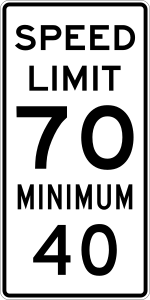
In addition to the legally defined maximum speed, minimum speed limits may be applicable. Occasionally, there are default minimum speed limits for certain types of roads, generally freeways.
Comparable to the common basic speed rule, most jurisdictions also have laws prohibiting speeds so low they are dangerous or impede the normal and reasonable flow of traffic.
Truck speed limits
Some jurisdictions set lower speed limits that are applicable only to large commercial vehicles like heavy trucks and buses. While they are called "truck speed limits", they generally do not apply to light trucks.
A 1987 study said that crash involvement significantly increases when trucks drive much slower than passenger vehicles, suggesting that the difference in speed between passenger vehicles and slower trucks could cause crashes that otherwise may not happen.[96] In a review of available research, the Transportation Research Board said "[no] conclusive evidence could be found to support or reject the use of differential speed limits for passenger cars and heavy trucks" and "a strong case cannot be made on empirical grounds in support of or in opposition to differential speed limits".[97]:11:109 Another study said that two thirds (67%) of truck/passenger car crashes are the fault of the passenger vehicle.[98]
Night speed limits

The basic speed rule requires drivers adjust speeds to the conditions. This is usually relied upon to regulate proper night speed reductions, if required. Numeric night speed limits, which generally begin 30 minutes after sunset and end 30 minutes before sunrise, are occasionally used where, in theory, safety problems require a speed lower than what is self-selected by drivers.
Examples include:
- Some streets in Tucson, Arizona, without street lights.
- Some roads along Interstate 90 in Montana
- Some Florida roads near Southwest Florida International Airport near Cape Coral/Fort Myers. (Most of these roads are labeled as "Panther Zones" or "Panther X-ing" areas.)
- Daniels Parkway Ext., a four-lane divided highway near SW Florida International Airport with a 50 mph (80 km/h) daytime limit, and a night speed limit of 45 miles per hour (72 km/h) is considered by many to be a speed trap. This road joins neighboring SR 82, a two-lane road with a 60 mph (97 km/h) speed limit.
- Colorado Highway 13, with a 65 mph (105 km/h) day/55 mph (89 km/h) night speed limit beginning 7.1 mi (11.4 km) north of I-70 from north of Rifle to Colorado Highway 64 south of Meeker. Rural Colorado Highway 13 is 55 mph (89 km/h) at night north of Meeker all the way to the Wyoming state line.
- Highway 20 in Washington state between Twisp and Pateros has a 45 mph (72 km/h) speed limit due to high numbers of deer (and other wildlife) activity. Deer carcasses can be seen along the road all throughout summer
Some states create arbitrary night speed limits applicable to entire classes of roads. Until September 2011, Texas had a statutory 65 mph (105 km/h) night speed limit for all roads with a higher limit. Montana has a statutory 65 mph (105 km/h) night speed limit on all federal, state, and secondary roads except for Interstates.
Political considerations
Financial concerns
Traffic violations can be a lucrative income source for jurisdictions and insurance companies. For example:
- The town of Westlake, Texas, took in $42,000 per citizen over nine years for its speed traps.[99][100]
- Insurance companies may receive several billions of dollars annually in traffic ticket surcharges.[101]
- A study by the Federal Reserve of St. Louis found that traffic ticket writing increases when government revenue decreases.[102]
- 2008 debates over traffic enforcement in Dallas County, Texas, involved concerns of lost profits if ticket writing decreased.[103][104][105]
- In Massachusetts, half of the ticket money goes to the police department that writes the speeding ticket, the other half goes to fund the court that convicts the speeder or collects the fine from them.
Thus, an authority that sets and enforces speed limits, such as a state government, regulates and taxes insurance companies, who also gain revenue from speeding enforcement. Furthermore, such an authority often requires "all" drivers to have policies with those same companies, solidifying the association between the state and auto insurers. If a driver cannot be covered under an insurance policy because of high risk, the state will assume that high risk for a greater monetary amount; thus resulting in even more revenue generation for the state.[106]
When a speed limit is used to generate revenue but has no safety justification, it is called a speed trap. The town of New Rome, Ohio was such a speed trap, where speeding tickets raised up to $400,000 per year to fund the police department of a 12-acre village with 60 residents.[107]
Environmental concerns
Reduced speed limits are sometimes enacted for air quality reasons. The most prominent example includes Texas' environmental speed limits.
Definition of speeding
Either of the following qualifies a crash as speed-related in accordance with U.S. government rules:[108]
- Exceeding speed limits.
- Driving too fast for conditions.
Speeds in excess of speed limits account for most speed-related traffic citations; generally, "driving too fast for conditions" tickets are issued only after an incident where the ticket issuer found tangible evidence of unreasonable speed, such as a crash. Driving too fast for conditions is sometimes cited when a motorist is caught exceeding the posted speed limit, but the speed falls below a state's "default" speed limit codified in law. This makes it difficult for the motorist to get out of a ticket by claiming the speed at which he or she was travelling was within the state's legal speed limit, despite the lower posted speed limit for which the motorist may or may not have been aware of.
A criticism of the "exceeding speed limits" definition of speeding is twofold:
- When speed limits are arbitrary, such as when set through political rather than empirical processes, the speed limit's relationship to the maximum safe speed is weakened or intentionally eliminated. Therefore, a crash can be counted as speed-related even if it occurs at a safe speed, simply because the speed was in excess of a politically determined limit.
- The effective limit may still be too fast for certain conditions, such as limited visibility or reduced road traction[109] or even low-speed truck rollovers on exit ramps.[110]
Variable speed limits offer some potential to reduce speed-related crashes. However, due to the high cost of implementation, they exist primarily on freeways. Furthermore, most speed-related crashes occur on local and collector roads, which generally have far lower speed limits and prevailing speeds than freeways.[111]
Prima facie
Most states have absolute speed limits, meaning that a speed in excess of the limit is illegal per se. However, some states have prima facie speed limits.[112] This allows motorists to defend against a speeding charge if it can be proven that the speed was in fact reasonable and prudent.
Speed limits in Texas,[113] Utah,[114] and Rhode Island are prima facie. Some other states have a hybrid system: speed limits may be prima facie up to a certain speed or only on certain roads. For example, speed limits in California up to 55 mph, or 65 mph on highways, are prima facie, and those at or above those speeds are absolute.[115]
A successful prima facie defense is rare. Not only does the burden of proof rest upon the accused, a successful defense may involve expenses well in excess of the cost of a ticket, such as an expert witness. Furthermore, because prima facie defenses must be presented in a court, such a defense is difficult for out-of-town motorists.
Metric speed limits
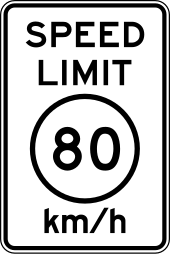
Metric speed limits are no longer included in the Federal Highway Administration's Manual on Uniform Traffic Control Devices (MUTCD), which provides guidelines for speed limit signage,[116] and therefore, new installations are not legal in the United States. Prior to 2009, a speed limit could be defined in kilometers per hour (km/h) as well as miles per hour (mph). The 2003 version of the MUTCD stated that "speed limits shown shall be in multiples of 10 km/h or 5 mph."[117] If a speed limit sign indicated km/h, the number was circumscribed and "km/h" was written below. Prior to 2003, metric speed limits were designated using the standard speed limit sign, usually with yellow supplemental "METRIC" and "km/h" plaques above it and below it, respectively.[118][119]
In 1995, the National Highway System Designation Act prohibited use of federal funds to finance new metric signage.
See also
- Driver License Compact
- Non-Resident Violator Compact
- Solomon curve
- Traffic violations reciprocity
- Transportation safety in the United States
- Traffic code in the United States
Notes
- Although the maximum posted speed limit in the state is 70 mph (113 km/h), state law allows a maximum posted speed of 75 mph (121 km/h) (for possible raising of speed limits in the future) on rural freeways.
References
- "Speeding & Speed Limits Index & Overview". www.safeny.ny.gov. Retrieved March 21, 2019.
- http://www.asbar.org/index.php?option=com_content&view=category&id=583&Itemid=172 Asbar.org. Title 22 - Highways and Motor Vehicles. Chapter 03 - Rules of the Road. Retrieved July 7, 2019.
- Wake Island Code
- Midway Atoll Code
- Flamm, Bradley (2006). "Putting the brakes on 'non-essential' travel: 1940s wartime mobility, prosperity and the US Office of Defense". The Journal of Transport History. 27 (1): 71–92, 79. doi:10.7227/TJTH.27.1.6.
- "Nixon Approves Limit of 55 MPH". The New York Times. January 3, 1974. pp. 1, 24. Retrieved July 22, 2008. (subscription required)
- Blair, William G. (4 April 1987). "55-m.p.h. Signs Sprout Out West, but New York Region Holds Off". The New York Times. Retrieved 21 August 2016.
- "H.R.2 – 100th Congress (1987–1988): Surface Transportation and Uniform Relocation Assistance Act of 1987". Congress.gov. Library of Congress. 2 April 1987. Retrieved 21 August 2016.
- "Alabama Law Enforcement Agency". Dps.alabama.gov. Retrieved 2017-07-07.
- "Alabama Law Enforcement Agency". Dps.alabama.gov. Retrieved 2017-07-07.
- http://www.frommers.com/destinations/americansamoa/3038010002.html Frommer's - Planning a Trip in American Samoa. Retrieved July 7, 2019.
- Arizona Statutes Chapter 3 Article 6 State Legislature
- "Arkansas Act 784". Arkansas State Legislature. Retrieved 16 May 2020.
- "California Highways with 70 MPH Speed Limits". ca.gov. Retrieved 11 July 2016.
- "Subchapter VIII. Speed Restrictions". Delaware State Legislature. May 19, 2008.
- District of Columbia Municipal Regulations Title 18 – Vehicle and Traffic (March 1997), chapter 22 "Moving Violations"
- "Florida Department of Transportation". state.fl.us. Retrieved 11 July 2016.
- "HB 674 – Maximus Speed Limots; vehicles having greater than 6 wheels". Georgia House of Representatives. May 21, 2008.
- "Guam Code Annotated Title 16 Chapter 3 Article 3 § 3301" (PDF). Justice.gov.gu. Retrieved 2017-07-07.
- Matthew L. Wald (1997-06-06). "Guam Is the Pace-Setter In Driver Seat-Belt Use". The New York Times. Retrieved 2017-07-07.
- "Guam Vacation Guide | Request Free Visitor's Guide". Visitguam.org. 1970-01-01. Retrieved 2017-07-07.
- "Senate Transportation Committee Approves Speed Limit Increase". Kentucky Transportation Cabinet. February 1, 2006.
- "Louisiana State Legislature". legis.la.gov. Retrieved 5 July 2017.
- "Public Michigan Vehicle code: Speed Restrictions". Michigan Legislature. November 9, 2006. Retrieved April 30, 2007.
- "Michigan House approves 75 mph speed limit hike". Retrieved 5 July 2017.
- 169.14, Minnesota Statute. Revisor.leg.state.mn.us (August 1, 2009).
- HEAT Speed Management Program. Dot.state.mn.us.
- "Home – Nebraska Department of Transportation" (PDF). Nebraskatransportation.org. Retrieved 5 July 2017.
- Nitzman, Alex (2012-07-16). "Nevada @ AARoads – Interstate 80". AARoads.com. Retrieved 2016-07-26.
Contrary to popular belief, the speed limit on Interstate 80 is not 75 mph all the way across Nevada. The speed limit stays at 65 mph from the California line into the Reno-Sparks metro area and eastward all the way to Milepost 23 near the Mustang Ranch.
- Press, Associated. "Nevada implementing 80 mph speed limit on I-80". KSNV. Retrieved 2017-05-06.
- "Nevada freeway speed limit to get bump to 80 mph". Las Vegas Review-Journal. 2017-05-03. Retrieved 2017-05-06.
- New Jersey General Assembly. "N.J.S.A. 39:4-98(b)". Statutes of New Jersey. New Jersey.
- "Appendix A Designated 65mph Roadway Segments" (PDF). State of New Jersey & New Jersey Department of Transportation. April 24, 2008.
- New Mexico Statutes Chapter 66 Article 7 part 4 Mexico State Legislature or nmlaws.org
- NY State Vehicle and Traffic (VAT) Law § 1180-a Laws of New York State. Leginfo.state.ny.us.
- "North Carolina General Statutes § 20-141(d)(2). Speed restrictions". North Carolina State Legislature. April 23, 2008.
- "NCDOT, Strategic Highway Corridors, Facility Types and Control of Access Definitions". North Carolina Department of Transportation. April 23, 2008. Archived from the original on March 27, 2012.
- "NCDOT, Strategic Highway Corridors, Facility Types and Control of Access Definitions: Expressways". North Carolina Department of Transportation. April 23, 2008. Archived from the original on March 27, 2012.
- "CHAPTER 39-09: Speed Restrictions" (PDF). Legis.nd.gov. Retrieved 2017-07-07.
- "North Dakota Speed Zone Map". Dot.nd.gov. Retrieved 5 July 2017.
- dot.nd.gov
- "| GHSA". Ghsa.org. Retrieved 2017-01-07.
- "Lawriter – ORC". codes.ohio.gov. Retrieved 5 July 2017.
- Provance, Jim (September 28, 2013). "Speed limits rising to 70 mph for some state roads Sunday". Toledo Blade. Retrieved July 11, 2016.
- "Speed limit on U.S. 30 bumped to 70 mph". The Lima News. June 25, 2015. Retrieved July 11, 2016.
- Ohio Transportation Map. Ohio Department of Transportation, 2015. US 30, cited in the Lima News as 70 mph from the Indiana line to Mansfield, is not shown as freeway.
- § 5122. Maximum lawful speed limits and penalties., Subchapter IV, Chapter 27, Title 9 of the Laws of Puerto Rico
- "Rhode Island Division Of Motor Vehicles: General Information". State Of Rhode Island, Division Of Motor Vehicles. May 27, 2008.
- "S.C. Code Of Laws Title 56 Chapter 5 Uniform Act Regulating Traffic On Highways". South Carolina State Legislature. May 1, 2008.
- "Maximum posted speed limits". Insurance Institute for Highway Safety. Retrieved January 6, 2017.
- "What are the speed limits in South Dakota?". South Dakota Highway Patrol. Archived from the original on June 14, 2009. Retrieved July 2, 2009.
- Section 494. speed limits, Chapter 43, Part II, Title 20 of the Virgin Islands Code , and from a NHTSA summary
- Troopers plan to strictly enforce new 80 mph speed limit. ksl.com (January 5, 2009).
- Utah Code 41-6a-601 – Speed regulations. le.utah.gov.
- Tribune, The Salt Lake. "70 mph speed limit now official on Utah's urban interstates". sltrib.com. Retrieved 11 July 2016.
The speed limit in Cedar City is 75 mph on I-15 besides bypasses that are nearby
- Utah Code 41-6a-602(3)(a)
- Va. Code § 46.2-870. Virginia Legislative Information System. Law.lis.virginia.gov.
- Washington State Department of Transportation (11 May 2016). "State officials will not raise I-90 speed limit in eastern Washington". wsdot.wa.gov. Retrieved 1 September 2016.
- Wisconsin Statute 346.57. (PDF).
- Wyoming Statutes. Legisweb.state.wy.us.
- "How to beat criminal speeding in Arizona A.R.S. §28-701.02". The Heath Law Firm. April 24, 2017.
- "Traffic Offenses For Which Court Appearance May Be Waived" (PDF). Nccourts.org. Retrieved 2017-07-07.
- "§ 20-16". state.nc.us. Retrieved 11 July 2016.
- "Home" (PDF). state.pa.us. Retrieved 11 July 2016.
- Transportation Code Chapter 542. General Provisions. Statutes.legis.state.tx.us.
- Transportation Code Chapter 542. General Provisions. Statutes.legis.state.tx.us.
- Transportation Code Chapter 545. Operation and Movement of Vehicles. Statutes.legis.state.tx.us.
- Transportation Code Chapter 545. Operation and Movement of Vehicles. Statutes.legis.state.tx.us.
- Code of Criminal Procedure Chapter 45. Justice and Municipal Courts. Statutes.legis.state.tx.us.
- Code of Criminal Procedure Chapter 45. Justice and Municipal Courts. Statutes.legis.state.tx.us.
- Transportation Code Chapter 708. Driver Responsibility Program. Statutes.legis.state.tx.us.
- Revised Statutes – Browse Document
- Va. Code § 18.2–11. Leg1.state.va.us.
- Va. Code § 46.2-873. Leg1.state.va.us.
- Va. Code § 46.2–878.1. Leg1.state.va.us (July 1, 2012).
- Va. Code § 46.2–874.1. Leg1.state.va.us.
- Va. Code § 46.2-878. Leg1.state.va.us.
- Va. Code § 46.2-862. Leg1.state.va.us.
- Va. Code § 46.2-861. Leg1.state.va.us.
- "Virginia SB63 | 2020 | Regular Session". LegiScan. Retrieved 2020-03-27.
- Va. Code § 46.2-492. Leg1.state.va.us.
- Commonwealth of Virginia, Department of Motor Vehicles, "Moving Violations and Point Assessments". Dmv.virginia.gov (May 14, 2007).
- Posted Highway Speed Limits Rise, Federal Highway Administration, U.S. Department of Transportation
- A Report of the Record Commissioners of the City of Boston containing the Boston Records From 1700 to 1728. 8. Boston: Rockwell and Churchill, City Printers. 1883. p. 12.
- "Chapter 1 - Federal-Aid Highways, Sec. 106 - Project approval and oversight". US Government Printing Office. 2011. Retrieved July 3, 2020.
- "Public Law 93-239 AN ACT To conserve energy on the Nation's highways" (PDF). Emergency Highway Energy Conservation Act. January 2, 1974. Retrieved July 3, 2020.
- 55: A Decade of Experience Special Report 204. Washington, D.C.: Transportation Research Board. 1984. pp. 31–34.
- Farmer, Charles M. (April 2019). The effects of higher speed limits on traffic fatalities in the United States, 1993–2017. Insurance Institute for Highway Safety. Retrieved July 3, 2020.
- "Persons Fatally Injured In Motor Vehicle Crashes, 1980 - 2017 (1) By Functional System National Summary 2/". Table FI-220. U.S. Department of Transportation, Federal Highway Administration, Policy and Governmental Affairs, Office of Highway Policy Information. October 2018. Retrieved July 3, 2020.
- "National Highway System Designation Act of 1995, Public Law 104-59" (PDF). US Government Printing Office. November 28, 1995. Retrieved July 3, 2020.
Section 205 Relief from Mandates .. (d)REPEAL OF NATIONAL MAXIMUM SPEED LIMIT COMPLIANCE PROGRAM
- Robbins, Jim (December 28, 1998). "Montana's Speed Limit of ?? M.P.H. Is Overturned as Too Vague". New York Times. Retrieved July 30, 2017.
- "Remember 'reasonable and prudent?' Speed limits long controversial in Montana". Missoulian.com. November 29, 2014. Archived from the original on December 3, 2014.
- Retting, Richard; Yeoh, Eric (2008). "Traffic Speeds on Interstates and Freeways 10 Years After Repeal of National Maximum Speed Limit". Traffic Injury Prevention. 9: 122, Table II. ISSN 1538-9588.
- https://www.iihs.org/api/datastoredocument/bibliography/2188
- https://www.iihs.org/api/datastoredocument/bibliography/2188
- table V-4. (PDF)
- Managing Speed: Review of Current Practices for Setting and Enforcing Speed Limits. Trb.org.
- The Unsafe Driving Acts of Motorists in the Vicinity of Large Trucks. (PDF).
- "Small North Texas town tops list in speeding-ticket revenue | wfaa.com Dallas – Fort Worth". Wfaa.com. March 23, 2010. Archived from the original on March 27, 2010.
- Texas's worst speed traps. Arencambre.com (March 4, 2010).
- Traffic Tickets Are Big Business. Blog.motorists.org (November 16, 2010).
- St. Louis Fed: WP 2006-048C "Red Ink in the Rearview Mirror: Local Fiscal Conditions and the Issuance of Traffic Tickets". Research.stlouisfed.org.
- Dallas County commissioners propose deal to eliminate traffic units, Dallas Morning News, June 27, 2008
- As motorists’ frustration rises, justices of the peace pull out of automated ticket payment program, Dallas Morning News, July 5, 2008
- Dallas County to scrap central collections for traffic tickets, Dallas Morning News, July 7, 2008
- Stephen Moore on Speed Limits on National Review Online. Nationalreview.com (June 25, 2003).
- Matt Hannafin (April 11, 2008). Highway Robbery: Coping with the Great American Speed Trap. Frommer's (John Wiley & Sons, Inc.). Retrieved September 8, 2012.
- U.S. federal government brochure Archived September 25, 2006, at the Wayback Machine
- Synthesis of Safety Research Related to Speed, Publication No. FHWA-RD-98-154 Archived June 13, 2006, at the Wayback Machine
- Vehicular Stability Systems (VSS) – Federal Motor Carrier Safety Administration. Fmcsa.dot.gov.
- Archived May 24, 2006, at the Wayback Machine
- State Traffic and Speed Laws. Mit.edu.
- Texas Transportation Code §545.351 and §545.352. Texas Legislature.
- Utah State Legislature.
- "CA Codes (veh:22348-22366)". ca.gov. Retrieved 11 July 2016.
- https://mutcd.fhwa.dot.gov/htm/2009r1r2/part2/part2a.htm
- FHWA – MUTCD – 2003 Edition Revision 1 Chapter 2B. Mutcd.fhwa.dot.gov.
- MUTCD and metric road signs in the US. Lamar.colostate.edu.
- New York Roads – I-87 – Northway. Alpsroads.net.
Law Review
- R. A. Vinluan (2008). "Indefiniteness of automobile speed regulations as affecting validity". American Law Reports—Annotated, 3rd Series. 6. The Lawyers Co-operative Publishing Company; Bancroft-Whitney; West Group Annotation Company. p. 1326.
- C. C. Marvel (2010). "Meaning of "residence district," "business district," "school area," and the like, in statutes and ordinances regulating speed of motor vehicles". American Law Reports—Annotated, 2nd Series. 50. The Lawyers Co-operative Publishing Company; Bancroft-Whitney; West Group Annotation Company. p. 343.
